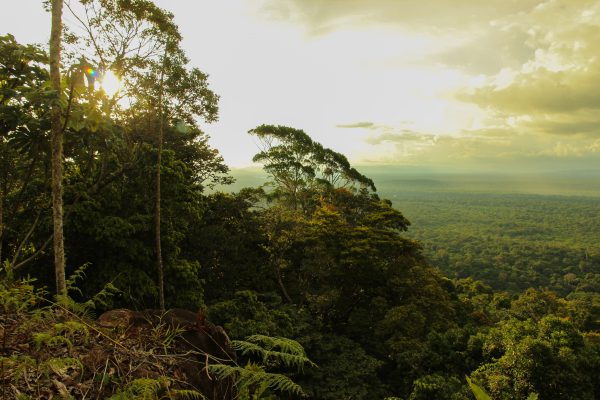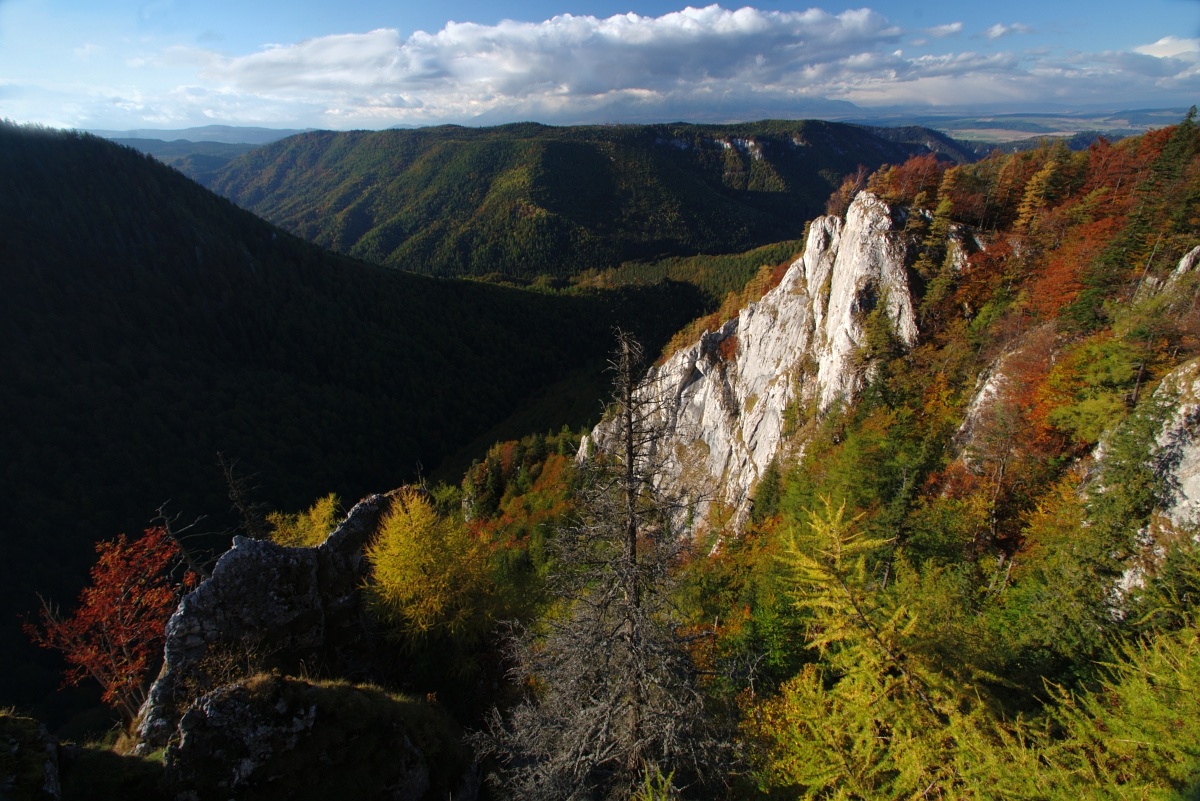

Slovak Paradise National Park (Národný park Slovenský raj) was officially recognized as a national park by the Slovak Government in 1988. In 2015, its zones and buffer zone were established again as Slovak Paradise National Park. Before becoming a national park, Slovak Paradise became Slovakia’s first protected landscape area in 1964.
Located in the Northeast part of the Slovak Ore Mountains, Slovak Paradise covers a 194.14 km2 area with a 54.75 km2 protected buffer zone, making the total area 248.89 km2. The national park is divided into four zones A to D with different degrees of protection. The park is open to the public all year round.
The topography of Slovak Paradise is predominantly characterized by a karst plateau. An original single plateau is now divided by gorges into several karst plateaus, such as the Geravy, Pelc, Skala, and Glac, the best preserved and largest at 3 km2. Forest covers around 90% of the park, with beech, fir, and spruce the most prevalent.
Mountain plains, deep canyons, gorges (up to 300 meters deep), waterfalls, surface karst features, and underground caves with stalactite and ice formations are typical phenomena of the landscape. The park contains approximately 700 caves, and the Dobšinská ľadová jaskyňa cave, the only one accessible to the public, is one of the largest ice caves in Europe. In 2000, the Dobšinská ľadová jaskyňa cave together with the Stratenská jaskyňa and Psie diery caves were listed as UNESCO World Natural Heritage sites.
The park’s highest point is Predná hoľa, 1545 meters above sea level, and the lowest point is the level of the river Hornád 470 meters above sea level. Because of the vertical height range in the gorges, a rare feature of Slovenský Raj is the occurrence of heat-seeking plants and animals at higher altitudes and cold-seeking species at the bottom.
Slovak Paradise has more than 4,000 species of invertebrates and 200 species of vertebrates, of which 130 are protected and 65 endangered, and 1000 vascular plant species, with 33 of them protected.
Animal species found in the park include the European brown bear, Eurasian lynx, grey wolf, red and roe deer, European river otter, wild boar, European ground squirrel, and birds of prey such as the endangered Golden eagle and Lesser Spotted Eagle. It has one of the few European snake species, the European adder, and its caves are the wintering habitat of 18 bat species, including the endangered Whiskered and Natterer’s bat. Slovak Paradise is also famous for butterflies, having more than 2,000 species.
Due to the national park’s rich biodiversity and outstanding natural beauty, Slovak Paradise is a popular tourist destination, attracting hundreds of thousands of visitors each year. Suchá Belá, a national nature reserve inside the park, is the most visited gorge, receiving around 1,000 visitors a day in the summer months. Other popular gorges are Piecky, Sokol, and Kyseľ. The gorges are accessed by aids such as ladders, chains, bridges, and wooden walkways to assist with climbing and crossings.
Within Slovak Paradise National Park and its protected zone, there are 277 km of marked hiking trails, 143 km of cycle routes, and 11 educational trails with a total length of 79 km. These marked trails guide visitor movements and provide information on the region’s natural, historical, and cultural values and raise awareness of their protection.
To protect particularly precious and fragile nature, “zones of silence” were created where visitors are not permitted to enter to safeguard the original natural environment and preserve protected and endangered species.
In addition to the marked trails and silent zones, other visitor management measures were needed to protect the area’s biodiversity, as long queues were damaging habitats, and visitors needed to be informed of the fragile nature of the area.
Although a highly popular national park, most visitors to Slovak Paradise only visited two or three sites. This brought several environmental problems such as damage to soil cover and vegetation and the pollution of underground water because of a lack of toilets. In addition, visitors had a low awareness of the park’s values and reasons for its protection and a high number of visitors concentrated on a few sites also worsened the visitor experience.
To address these issues, a project by Ecological Tourism in Europe, “Implementation of the effective visitor management of Slovensky Raj National Park”, was carried out between October 2020 and April 2022 to improve the protection of biodiversity in the national park by introducing urgently needed visitor management measures.
As part of the project, initiatives were introduced that focused on new and innovative methods of visitor management in popular areas of the park. To avoid direct regulations and prohibitions, indirect methods, such as leading visitors into sensitive gorge environments in a no-harm way, dispersing visitors to other tourist attractions (for example, other gorges), and making inevitable regulations more flexible than before, such as the closure of gorges for a couple of hours or days, giving a specific reason, for example, heavy rainfall.
Other measures included improving the technical access aids in gorges to keep tourists away from sensitive habitats, shaping descent trails to mitigate erosion and trampling, informing visitors about wider hiking opportunities, providing ecological toilets at busy sites, etc. Besides these traditional means, new information and communication technologies were used. For example, outdoor display monitors to notify visitors that other gorges existed and were accessible to direct them away from the two most popular gorges, unforced time regulation of entrance into the most loaded gorge, and making the closure of gorges due to high-water levels as quick as possible.
In addition, the project used the unexpected opportunity of a state nature protection administration reform to launch a new approach to the management of the national park as a tourism destination.
The region around Slovak Paradise National Park is also a good example of how local communities can cooperate with protected area management to lower the negative impacts of tourism on nature while increasing the positive impacts on the local community.
While tourism brings some negative environmental impacts, it also provides a livelihood for a large part of the local population, who offer visitors services like accommodation, meals, and equipment rental. In addition, with the collection of a park entrance fee, tourists bring important income to the public budgets of the national park’s gateway municipalities.
Thus, two of the main destination stakeholders – the national park administration and the destination management organization – jointly prepared this visitor management initiative to lower the negative impacts of tourism on the natural environment. The main principle of this initiative is to distribute visitors to sites and times without significantly decreasing numbers. The aim is to maintain the social and economic benefits while mitigating the negative environmental impacts.
The Slovak Paradise National Park administration plans to continue developing tourism activities with an emphasis on nature protection in cooperation with local stakeholders. This activity is mainly focused on increasing the quality of visits, not quantity, as the number of visitors to the national park is already at its limit.
During the pandemic, visitor numbers dropped significantly, which caused substantial income losses for local communities, but now numbers are back to normal.
The national park’s management created the possibility for the safe movement of people during repeated quarantines, lockdowns, and social distancing. However, current crises concerning increasing fuel prices and consumables will require alternative actions, making sure income for local communities is maintained, possibly on a lower level.
© Linking Tourism & Conservation (LT&C) 2019
We are grateful that you support the work and mission of LT&C! We accept donations through Credit Card, PayPal or international bank transfer:

Donate through Credit Card
Please click the Donate button and then choose your PayPal account
Bank details:
Cultura Sparebank
Pb. 6800, St. Olavs plass
N-0130 Oslo
Name: Linking Tourism & Conservation,
Account no.: 1254 05 95168
IBAN: NO8712540595168
BIC/SWIFT: CULTNOK1
Routing BIC: DNBANOKK
Please mark payments with your name and/or email address
Sign up for an LT&C membership by filling in the details below.
Would you like your LT&C-Example/Initiative to be listed on our website? Please fill in the form below.